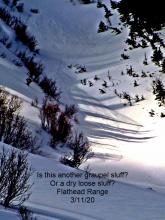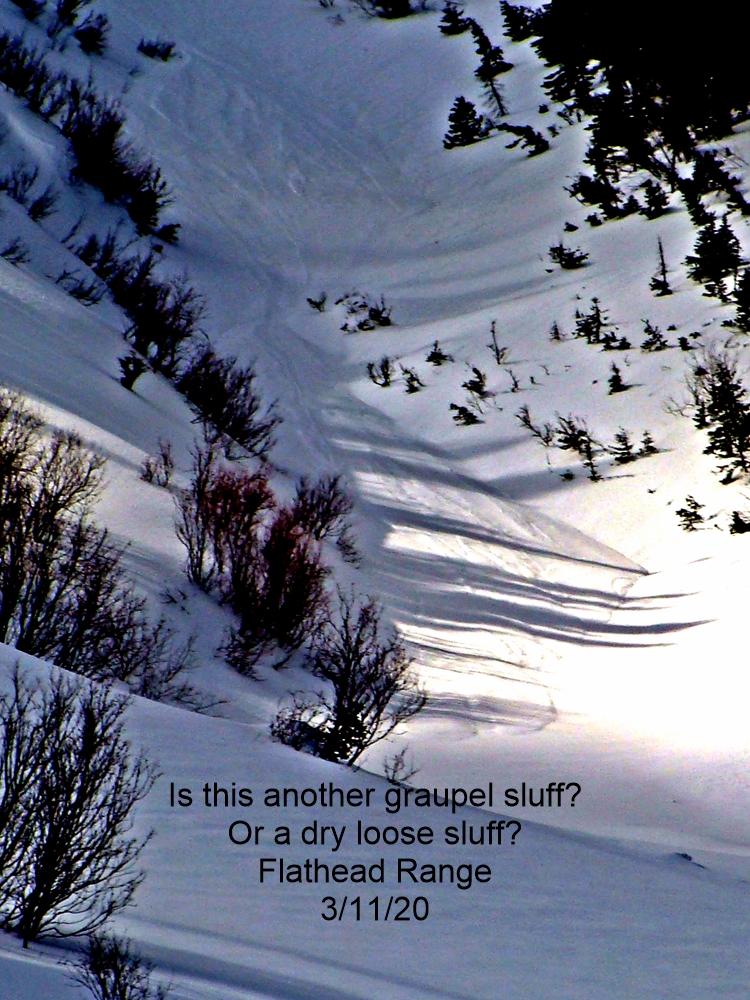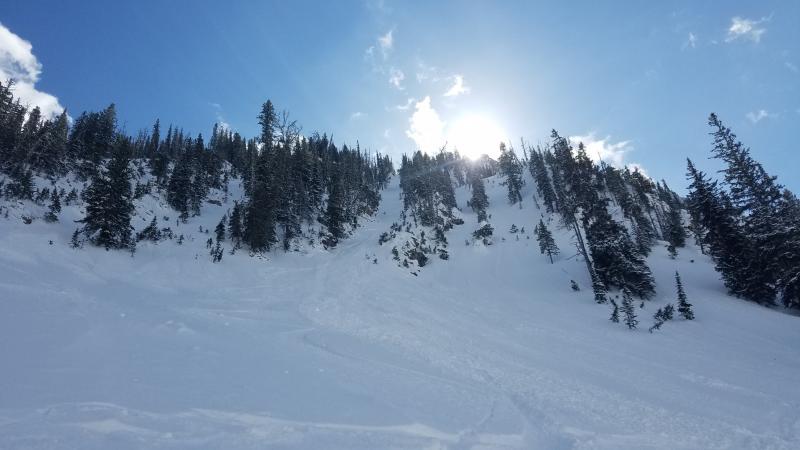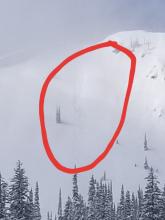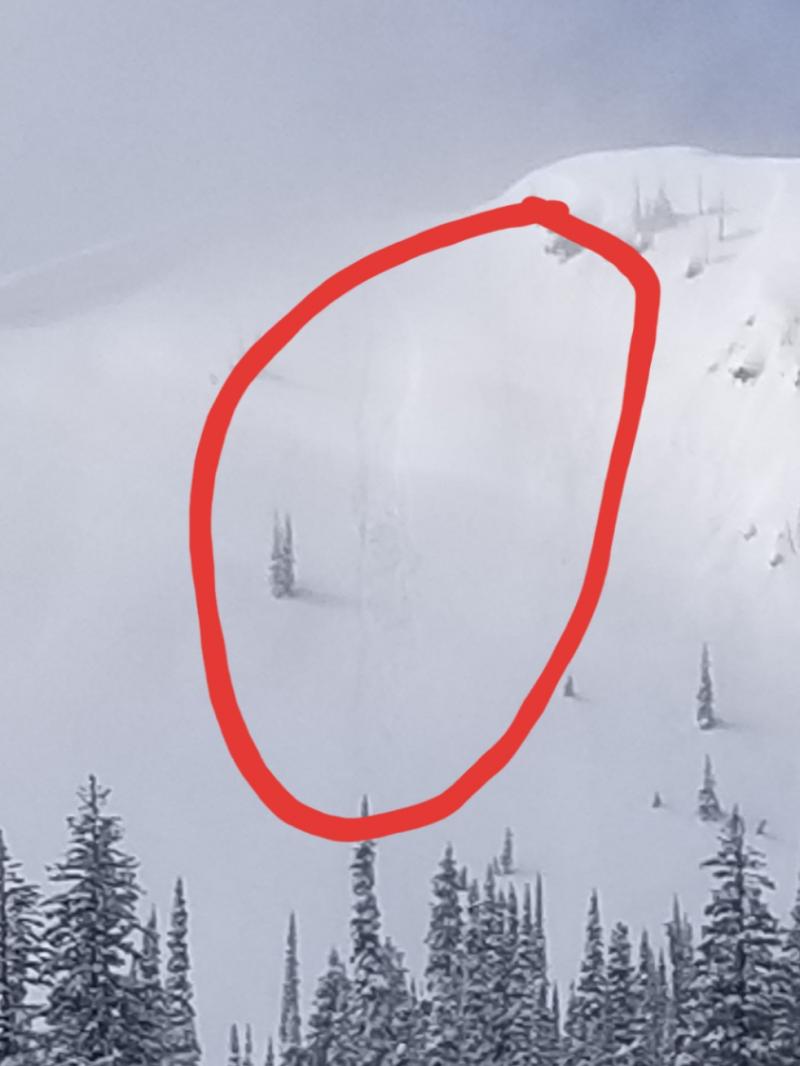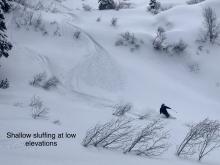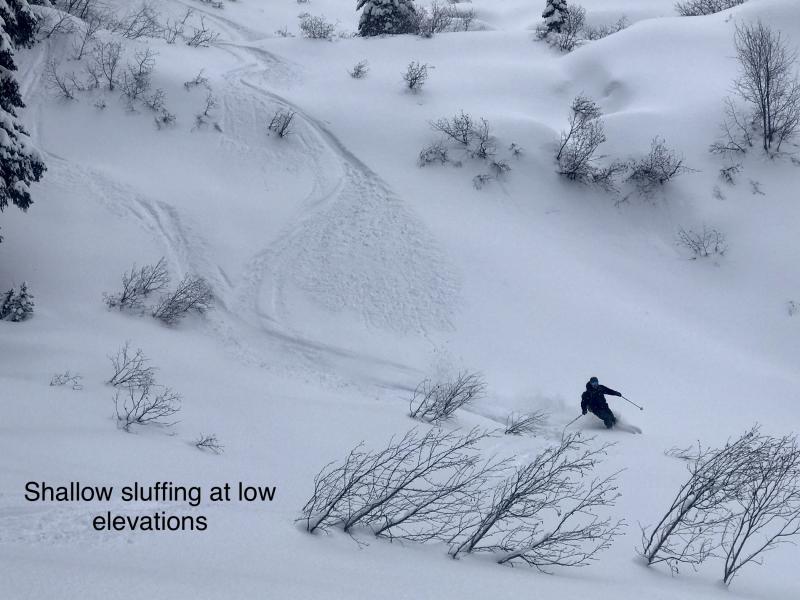| Tuesday | Tuesday Night | Wednesday | |
|---|---|---|---|
| Cloud Cover: | Snow developing this afternoon. | Snow showers with windy conditions. | Snow tapering in the afternoon with windy conditions continuing. |
| Temperatures: | 31-43 deg. F. | 21-28 deg. F. | 32-43 deg. F. |
| Wind Direction: | S-SW | S-SW | W-SW |
| Wind Speed: | 7-11 gusts 17-24 | 14-21 gusts 36-48 | 13-21 gusts 28-40 |
| Snowfall: | 0-1 in. | 0-2 in. | 1-3 in. |
| Snow Line: |
Whitefish Range
Swan Range
Flathead Range and Glacier National Park
How to read the forecast
The avalanche danger is MODERATE above 5000 feet. Recent snow and strong winds formed fresh wind slabs at mid and upper elevations and these should continue to form today. Carefully evaluate recent windslabs before committing to a slope. Yesterday's snow was deposited on a crust and loose dry avalanches could be initiated today by a skier or rider on steep terrain. In all other terrain the danger is LOW. Continue to practice safe travel techniques.

2. Moderate
?
Above 6500 ft.
2. Moderate
?
5000-6500 ft.
1. Low
?
3500-5000 ft.
- 1. Low
- 2. Moderate
- 3. Considerable
- 4. High
- 5. Extreme
-
Type ?
-
Aspect/Elevation ?

-
Likelihood ?CertainVery LikelyLikelyPossible
 Unlikely
Unlikely -
Size ?HistoricVery LargeLargeSmall

Yesterday's moderate to strong winds, combined with recent snow, formed fresh wind slabs throughout our advisory area at mid and upper elevations. These slabs are found on leeward slopes and cross-loaded features. In some areas recent windslabs may have formed on a preserved layer of surface hoar making them more sensitive. In other areas they may have been deposited on a recently formed sun crust or rain crust, both of which will provide a great bed surface for these fresh slabs to slide on. With the abnormally brisk winds we received yesterday be aware that fresh wind slabs could be found lower on upper elevation terrain than what we are used to seeing along with unusual cross loading of mid and upper elevation terrain features. Continue to carefully evaluate all wind loaded terrain. Look for rounded pillows of wind drifted snow on leeward sides of ridges and cross-loaded areas in gullies at both mid and upper elevations.
-
Type ?
-
Aspect/Elevation ?
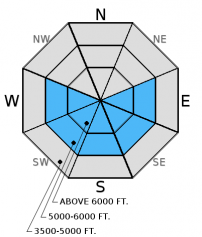
-
Likelihood ?CertainVery LikelyLikelyPossible
 Unlikely
Unlikely -
Size ?HistoricVery LargeLargeSmall

The new snow that fell during the day yesterday (Monday) was relatively low density and, on sunny aspects, was deposited on a sun crust formed 2/26. New snow accumulation was deepest at mid and upper elevations and initial reports are that this snow is not adhering to the underlying crust and is sluffing on steeper terrain. On shaded aspects you may find that the new snow may have fallen on a rain crust formed 2/27. These slides will be small but can be consequential if you are knocked off your feet or machine. This is an easy problem to recognize because these crusts are located just below the snow surface.
This season we dealt with an ever evolving persistent slab problem associated with widespread rain crusts and weak snow surrounding these crusts. As time has passed so has our concern with some of these rain crusts. Currently, we are still tracking the strength of the snow around the February 14 crusts. The Valentine's Day crust now has 1.5-3 feet of snow sitting on top of it. Keep in mind that even small avalanches can step down into this deeper layer.
Monday: USFS snowmobile observers were in the Doris/Alpha area of the northern Swan Range. They noted substantial ridgetop winds with associated wind loading down to 6000'.They were able to intentionally release small thin wind slabs in the new snow by kicking and ski cutting wind features (observation). Skiers in the southern Whitefish Range reported sluffing of the new snow in Canyon Creek.
Sunday: Skiers in Cascade Creek in the Flathead Range noted a 1 inch thick surface crust to 6000 feet. They reported good skiing above that and "interesting" skiing at low elevations.
Saturday: Erich was instructing an avalanche class in the Ghoulie Point area in the southern Whitefish Range. He noted active windloading along the ridgelines and surface hoar that was preserved and buried beneath 1-2 inches of new snow. Participants in the class also noted surface hoar in the area. Stability tests produced variable fractures in the upper snowpack without propagation(observation). Mark and Guy traveled to the Napa Point area in the Swan Range and noted the snow level was at 5900 feet and the area picked up 4 inches of dense snow above that. They also had minimal results in stability tests (observation).
Friday: Skiers in Rescue Creek in the Flathead Range witnessed large loose, wet avalanches on sunny slopes (observation). Skiers east of Marias Pass in the Flathead Range found variable snow conditions and noted strong winds and active wind drifting (observation). Erich was instructing an avalanche class in the southern Whitefish Range and observed small, loose wet avalanches (photo) and noted widespread surface hoar formation. Skiers on Skookoleel Ridge in the southern Whitefish Range found large surface hoar on multiple aspects that remained preserved through the heat of the day. They also observed large cornices that showed signs of weakening due to rising temperatures (observation).
Visit our Observations page and our You Tube channel for more observations from the entire season.
Thanks to everyone for submitting observations. They are extremely useful and could help save lives.
HOW TO SUBMIT OBSERVATIONS:
Email: [email protected]
Call and leave a message: 406.387.3821
You can also submit quick observations via text: 406.241.4571 (FAC mobile)
OR
Submit Snowpack Observations: http://www.flatheadavalanche.org/node/add/snowobs
Submit Avalanche Observations: http://www.flatheadavalanche.org/node/add/avyobs
In the past 24 hours we have received 0-5" of new snow with the majority of that falling during the mid to late morning hours yesterday. High temperatures were in the mid to upper 20s, with light to moderate winds accompanied by moderate to strong gusts. As of 6:00 a.m.temperatures above 6000 feet are 17º-27ºF and winds are out of the southwest 4-9 mph with gusts from 8-18 mph. Today temperatures should climb to the low to mid-30s, and winds will blow out of the south-southwest at 10-15 mph with maximum gusts along ridgelines between 21-30 mph. Another storm system will enter our area this afternoon.
| 0600 temperature: | 17-25 deg. F. |
| Max. temperature in the last 24 hours: | 21-29 deg. F. |
| Average wind direction during the last 24 hours: | WSW |
| Average wind speed during the last 24 hours: | 10-20 mph |
| Maximum wind gust in the last 24 hours: | 21-50 mph |
| New snowfall in the last 24 hours: | 0-5 inches |
| Total snow depth: | 75-100 inches |
This advisory applies only to backcountry areas outside established ski area boundaries. This advisory describes general avalanche conditions and local variations always occur. This advisory expires at midnight on the posted day unless otherwise noted. The information in this advisory is provided by the USDA Forest Service who is solely responsible for its content.














